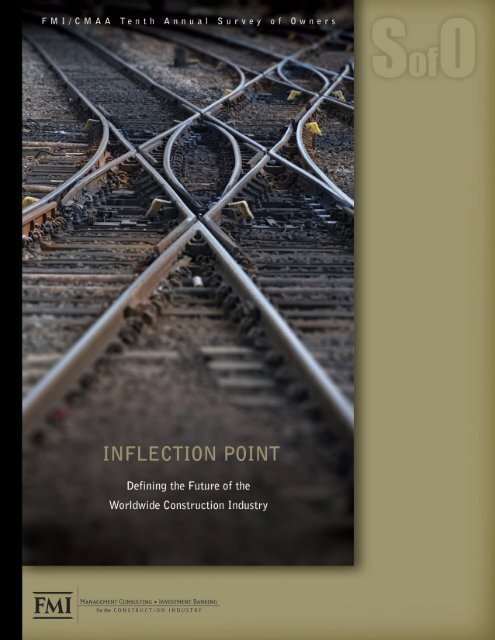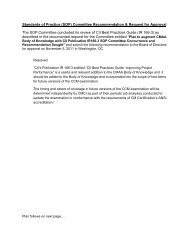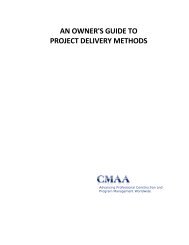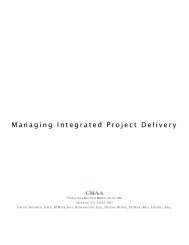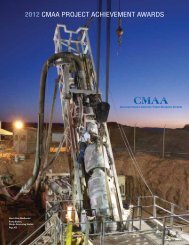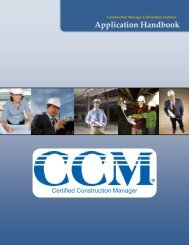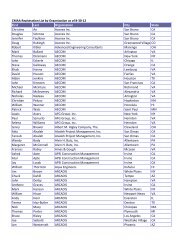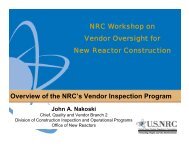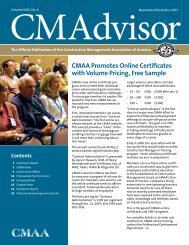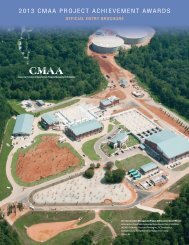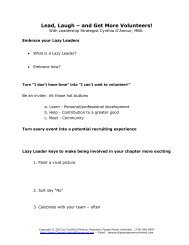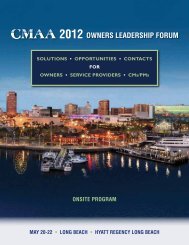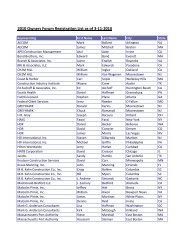FMI/CMAA Tenth Annual Survey of Owners
FMI/CMAA Tenth Annual Survey of Owners
FMI/CMAA Tenth Annual Survey of Owners
You also want an ePaper? Increase the reach of your titles
YUMPU automatically turns print PDFs into web optimized ePapers that Google loves.
TABLE OF CONTENTSExecutive Summary 2Highlights 3Methodology 4A/E/C Future Focus 4Scenario 1: Perfect World View 8Scenario 2: Struggle for Sustainability 9Scenario 3: Building Walls 10Scenario 4: Controlled Environment 11<strong>Survey</strong> Results 13Demographics 22Conclusion 25AcknowledgementsThis <strong>Tenth</strong> <strong>Annual</strong> <strong>Survey</strong> <strong>of</strong> <strong>Owners</strong> is possible only through the leadership provided by ConstructionManagement Association <strong>of</strong> America (<strong>CMAA</strong>). In addition, special thanks go to the owner members <strong>of</strong> <strong>CMAA</strong>,Construction Users Roundtable (CURT), Council <strong>of</strong> Educational Facility Planners International (CEFPI),Construction <strong>Owners</strong> Association <strong>of</strong> America (COAA), International Society <strong>of</strong> Pharmaceutical Engineers (ISPE),Western Council <strong>of</strong> Construction Consumers (WCCC), Construction Industry Institute (CII), North CentralElectric Association (NCEA), Society <strong>of</strong> American Military Engineers (SAME), National Association <strong>of</strong> Industrialand Office Properties (NAIOP), and Health Facility Institute (HFI). Consulting, technology and other serviceproviders to the AEC industry including AutoDesk, Contax LLC, e-Builder and Meridian Systems, supported thedistribution <strong>of</strong> the survey request to their customers. Several friends <strong>of</strong> <strong>FMI</strong> assisted in international or marketsegment specific distribution. These friends include Dr. Dongping Fang and Dr. Jiayi Pan both from TsinghuaUniversity in Beijing, David Bentley, Dr. Paul Giammalvo, Bart Grasso, Glyn Hazelden, Peter Hessler, and AngusWarren. Last, <strong>FMI</strong> and <strong>CMAA</strong> would like to thank Mimi Wheeler, an intern from North Carolina State Universityfor her input and analysis.Copyright © 2009 <strong>FMI</strong> Corporation. All rights reserved. No part <strong>of</strong> this publication may be reproduced or transmitted in any form or by any means without permissionfrom the publisher: <strong>FMI</strong> Corporation, 5171 Glenwood Ave., Raleigh, North Carolina, 27612, 919.787.8400.
EXECUTIVE SUMMARY2009 marks the tenth time that <strong>FMI</strong> and the Construction Management Association <strong>of</strong> America (<strong>CMAA</strong>) have collaboratedon a survey <strong>of</strong> construction owners. These surveys have addressed such current topics as accelerating use <strong>of</strong> programmanagement, implementation <strong>of</strong> Building Information Modeling (BIM), and more effective risk management strategies.Individually, the surveys present snapshots <strong>of</strong> practices and attitudes in the owner community at given points in time.Collectively, they <strong>of</strong>fer an opportunity to follow changes in these attitudes and practices and gain early insight intosubjects that are becoming more or less important to owners over time.The 2009 survey expressly takes this approach and was designed to assess how owner practices have changed in recentyears. During 2008 and 2009, the economic and financial turmoil has resulted in a dramatic shift in the business environmentfor the A/E/C industry. This shift or “inflection point” represents a moment <strong>of</strong> dramatic change. In the A/E/Cindustry, typically it is five to ten years before we can look back and recognize the curvature shift. The <strong>Tenth</strong> <strong>Annual</strong> <strong>Survey</strong><strong>of</strong> <strong>Owners</strong> examines the long-term trends affecting capital construction program management and focuses on how theconstruction delivery process, owner perspectives and necessary skill sets will transform the A/E/C industry over the next10-20 years.Four areas identified from the study demonstrated the greatest inflection:Outsourcing AccelerationSixty percent increase in Program Activation outsourcing since 2006Thirty percent increase in Operations and Maintenance (O&M) outsourcing since 2006Across the board increase in outsourcing <strong>of</strong> all other phases between 2009 to 2014Perspectives/Experiences Shift ImportanceIncreasing importance <strong>of</strong> maintenance supportProactive claims avoidance expectedIncreasing importance <strong>of</strong> aligning project delivery system selection to project characteristics and conditionsProactive and early project leadership desiredHolistic Strategy Driving Life Cycle Cost or Asset Management Approach to Capital ConstructionFive <strong>of</strong> eleven areas most frequently mentioned for improvement by owners relate to or infer the use <strong>of</strong> a life-cyclecosttype approachDominant Forces Shaping A/E/C IndustryGlobalizationSocial norms, mores, and expectationsTechnology application and innovationEconomic performancePolitical stabilityEnvironmental influenceIn the following pages are commentary and research results that document the feedback received. <strong>Owners</strong> and their variousservice providers can use this information as they struggle with the development <strong>of</strong> robust strategies to ensure their firmsthrive over the coming generation.2
HIGHLIGHTSUse <strong>of</strong> outsourcing in all project phases has either increased between 2006 to 2009 or will increase between 2009 and 2014Program activation/commissioning and O&M demonstrate a 60 percent and 30 percent acceleration in outsourceuse, respectively<strong>Owners</strong> are taking a more holistic view <strong>of</strong> their capital construction efforts and expect a broader set <strong>of</strong> services frompre-design to O&M functionsBetween 2009 and 2014 owners attach significantly more importance to the following areas:Selecting the most effective project delivery systemMaintenance management support in both process and technologiesProactive strategies to avoid claims and disputesDevelopment and use <strong>of</strong> a construction management planEffective documentation and processes designed to support facility commissioning or turnoverEighteen percent <strong>of</strong> owners cited team coordination achieved by applying technology enhancedprocesses as the area needing greatest improvementArchitects and general contractors are percieved as providing less coordination, whileprogram managers and construction management service providers are perceived asperforming better in this regard[Highest value support]“Be proactive and makerecommendations; don’tsimply identify problemsand areas <strong>of</strong> risk.”– Large Institutional Education <strong>Owners</strong>Internal communication among owner staff and effective cost control and management efforts from their senior managersare areas needing improvement for many ownersKnowledge transfer, experience building through training, recruitment, and aging workforce solutions are top opportunitiesfor represented labor leaders to meet owners’ expectationsDifferent types and sizes <strong>of</strong> owners maintain different expectations and prioritiesToday, private/closely held organizations want a full range <strong>of</strong> services and more support, particularly in the pre-designor design phases and post-construction phasesToday and in the future, state agencies expect to perform the front-end activities in houseToday and in the future, publically traded owners do not want tactical help, particularly in monitoring cost, addressingcompliance, defining scope <strong>of</strong> work, and work conformance testingIn the future, federal agencies are anticipating the need for more help with upfront pre-design or design services andconstruction oversightIn the future, municipal agencies anticipate needing help with claims support and compliance monitoring activitiesLarge owners with programs greater than $500 million do not want tactical help, particularly in building budgets, definingscope <strong>of</strong> work, commissioning, finding likely claims and building schedulesSmall owners, with programs less than $100 million, place the greatest importance on services that occur before constructionbegins or post-construction, specifically, leading the project team, defining responsibilities, addressing designcomments, administrating contracts, building budgets and scopes <strong>of</strong> work, and commissioning or maintenance support.3<strong>FMI</strong>/<strong>CMAA</strong> <strong>Tenth</strong> <strong>Annual</strong> <strong>Survey</strong> <strong>of</strong> <strong>Owners</strong>
METHODOLOGYThe first group <strong>of</strong> survey questions asked owners about their current use <strong>of</strong> outsourced services across the different stages <strong>of</strong>a construction project and whether their rate <strong>of</strong> outsourcing was higher in 2009 than it had been in 2006, and what furtherchange they expected between now and 2014.The second group <strong>of</strong> questions presented 28 specific tasks or functions commonly performed by pr<strong>of</strong>essional construction andprogram managers and asked owners to determine the importance <strong>of</strong> each, using a scale that ranged from “not at all important”to “very important.” These 28 tasks were derived from a study conducted by <strong>CMAA</strong> in 2006 to identify the specific components<strong>of</strong> the Construction Management (CM) pr<strong>of</strong>ession and associate each <strong>of</strong> these functions with the CM Standards <strong>of</strong>Practice promulgated by <strong>CMAA</strong>.The 2006 study was part <strong>of</strong> an effort by the Construction Manager Certification Institute (CMCI) to achieve accreditation forits Certified Construction Manager (CCM) program from the American National Standards Institute. The study identified 120specific job functions in seven general areas: Project Management Planning, Cost Management, Time Management, QualityManagement, Contract Administration, Safety Management and CM Pr<strong>of</strong>essional Practice. It then surveyed practicing CMs todetermine the relative importance they assigned to each <strong>of</strong> these tasks. For the <strong>Tenth</strong> <strong>Annual</strong> <strong>Survey</strong> <strong>of</strong> <strong>Owners</strong>, <strong>FMI</strong> and <strong>CMAA</strong>selected 28 standards <strong>of</strong> practice from all seven functional areas.Finally, a third and optional set <strong>of</strong> questions provided owners with several alternative broad views <strong>of</strong> the future and asked howlikely they thought each scenario was and how it could affect their business.The survey produced extensive and detailed data presented in this report.A/E/C FUTURE FOCUSThe concept <strong>of</strong> an inflection point is built around the expectation that the environment will shift the market players’ perspectivesand behavior. To better understand these shifts, <strong>FMI</strong> prepared a series <strong>of</strong> four scenarios, introducing them, defining implicationsand describing winning strategies. These scenarios are presented in summary form in the following pages along with the fourinflection points identified in this research.Inflection Point: Outsourcing AccelerationUse <strong>of</strong> outsourcing in all project phases either increased between 2006 to 2009 or will increase between 2009 and 2014(Exhibit 1). Design services and construction performance fall in outsourcing frequency between 2006 and 2009 and may berelated to the financial crisis and recession <strong>of</strong> 2008-2009. Many owners either deferred projects or kept many <strong>of</strong> their preconstructionactivities in-house. <strong>FMI</strong> believes the current decline in outsourcing will reverse once the level <strong>of</strong> pre-design,design oversight and design activities returns to normal.<strong>FMI</strong> Management Consulting24
Exhibit 1Outsourcing Trends% Outsourced90%80%70%60%50%40%30%20062009201420%10%0%Pre-DesignDesignOversightDesignServicesProcurementServicesConstructionOversightConstructionPerformanceProgramActivationOperations andMaintenanceNotably, the outsourcing <strong>of</strong> program activation and O&M will increase significantly, 60 percent and 30 percent respectively, andrepresents evidence <strong>of</strong> a long-term trend demanding a broader set <strong>of</strong> services from traditional design and construction firms.<strong>FMI</strong> has long believed one <strong>of</strong> the transformations occurring in the design/construction markets is a shift away from “silo”sourcing <strong>of</strong> services and toward preferred service providers <strong>of</strong>fering multiple services.Inflection Point: Perspectives and Experiences Shift Importance <strong>of</strong> FunctionSeveral services or functions that are viewed as relatively unimportant today will gain dramatically in emphasis over the nextfive years (Exhibit 2). Four <strong>of</strong> these five “least important” factors in 2009 registered the greatest gains in importance over thenext five years.Falling just outside <strong>of</strong> the top five, “11c Commissioning: Completion and submission <strong>of</strong> all commissioning,facility turnover, LEED, and other documentation necessary to support facility transfer orcertification obtainable during the post-construction process” demonstrates one <strong>of</strong> the highestpercentage gains in “very” and “quite important” ratings, further reinforcing a shift in perspectivebetween 2009 and 2014.[Biggest change desired]“Familiarity withsustainable design/LEED”– National Retail Owner/DeveloperExhibit 22009 Lowest Importance Standards <strong>of</strong> PracticeStandards <strong>of</strong> Practice 2014 Overall 2014 “Very” and “QuiteImportance Gain Important” Gain Only8c Project Delivery System:Determine the best project delivery system…* 7.1% 16.7%12b Maintenance Management:Design a maintenance management system…* 9.2% 24.4%6c Avoid Claims: Develop strategies to avoid disputes and claims * 7.5% 17.7%6b Find Likely Claims: Identify elements…give rise to disputes and claims 7.3% 14.4%12c Maintenance Technology:Use GIS, GPS BIM to provide effective maintenance management * 26.4% 83.8%* Denotes factors registering the greatest gains in importance over the next five years25<strong>FMI</strong>/<strong>CMAA</strong> <strong>Tenth</strong> <strong>Annual</strong> <strong>Survey</strong> <strong>of</strong> <strong>Owners</strong>
Inflection Point: Holistic StrategyThese shifts in importance also portend a growing owner emphasis on true life-cycle cost calculation and an ever-strongerdesire for contractors to help them predict and control long-term costs. This holistic strategy can be observed by the increasingnumber <strong>of</strong> owners using both a program management, versus a project-centric, approach and an asset management approachto capital construction. This approach is demonstrated by the top 10 most important standards <strong>of</strong> practices containing at leastone practice originating from each <strong>of</strong> the major phases <strong>of</strong> the construction process. In addition, five <strong>of</strong> eleven areas mostfrequently mentioned for improvement by owners relate to or infer the use <strong>of</strong> a life cycle cost type approach.The most important services today remain so in the future. Presented in Exhibit 3 are four depictions <strong>of</strong> the most importantstandards <strong>of</strong> practice or activities as rated by responding owners.Exhibit 3Most Important Standards <strong>of</strong> Practice2009 Most Important Standards <strong>of</strong> Practice 2014 Most Important Standards <strong>of</strong> PracticeTop 10 OverallImportance10c - Work Conformance9e - Contractor Compliance10d - Risk Mgt.10b - Build Schedule8d - Scope <strong>of</strong> Work11d - Punch List6e - Design Conformance11b - Monitor Testing7d - Address Comments9c - Critical-Path ScheduleTop 5 “Very” and“Quite Important” Only10c - Work Conformance9e - Contractor Compliance8d - Scope <strong>of</strong> Work11d - Punch List9c - Critical-Path ScheduleTop 10 OverallImportance10c - Work Conformance9e - Contractor Compliance10d - Risk Mgt.10b - Build Schedule8d - Scope <strong>of</strong> Work6e - Design Conformance6d - Monitor Cost7d - Address Comments9c - Critical-Path Schedule11b - Monitor TestingTop 5 “Very” and“Quite Important” Only10c - Work Conformance9e - Contractor Compliance10b - Build Schedule10d - Risk Mgt.7d - Address CommentsToday’s top two concerns, as measured by the frequency <strong>of</strong> “very” and “quite important” rankings only, deal chiefly with assuringthat a project is built in conformance with the contract documents. They remain the most important considerations five yearsfrom now. The third through fifth items in 2014, measured by the frequency <strong>of</strong> “very”and “quite important” rankings, although new to the “top five” in 2014, are actuallyranked sixth through eighth in 2009, and have moved up without changing their order.The three items they replace – scope <strong>of</strong> work, punch list, and critical path schedule –will fall out <strong>of</strong> the top five to 13th, eighth and ninth positions, respectively. “8d Scope<strong>of</strong> work: Developing the scope <strong>of</strong> work for bid packages” is the only 2009 top five factorthat falls out <strong>of</strong> the top 10 in 2014.[Greatest area for improvement]“Lack <strong>of</strong> critical thinking, communicationand writing skills area major detriment to projects”– Large U.S. City, Public Works DirectorIn some cases a relatively small gain in importance rating has resulted in a move <strong>of</strong> severalspaces up the ranking list. For example, “7d Address Comments: Ensure that reviewcomments are adequately addressed during the design phase” is ranked as quite or very important by 85 percent <strong>of</strong> respondentstoday and 92 percent for 2014, a gain <strong>of</strong> 9 percent. This gain was sufficient to move this factor from eighth place to fifth.Team coordination in some form was mentioned most <strong>of</strong>ten across all provider categories. This includes integrated projectdelivery, more use <strong>of</strong> BIM, adoption <strong>of</strong> 3D and 4D design techniques, and similar factors. The processes necessary to implementthese types <strong>of</strong> techniques demand integration across the construction supply chain and are also necessary to utilize a full lifecycle or asset management approach to capital construction.Taken together, the combination <strong>of</strong> highly important standards <strong>of</strong> practice and general comments describe an environmentwhere owners <strong>of</strong> all types are looking for a more effective collaborative approach from their service providers. This is fullyconsistent with the comprehensive view <strong>of</strong> projects that is revealed by the other survey questions.<strong>FMI</strong> Management Consulting26
A/E/C FUTURES RESEARCHWhat?During 2008 and 2009, the economic and financial turmoil has resulted in a dramatic shift inthe way the business environment for the architecture, engineering and construction (A/E/C)industry will affect the participants. <strong>FMI</strong>/AMI undertook a research effort to better define thisshift and support industry participants in addressing the following:Clearly define critical uncertainties and certaintiesIdentify as many potential wildcards as possible and bring them to lightArticulate strategic implications <strong>of</strong> each scenario and describe the resulting market shapeShare winning strategies that will leverage or defend against the strategic implicationsThe responses to these areas answer a key question, “What might that future look like?” <strong>FMI</strong>/AMI described four possiblefutures to engage and stimulate senior leaders as they struggle with the development <strong>of</strong> robust strategies to ensure their firmsthrive over the coming generation.Why?The conventional wisdom is that the A/E/C industry does not shape its own destiny; instead, it reacts and responds to theeconomy, owner demands, labor needs, etc. The typical planning cycle for the majority <strong>of</strong> firms is 1-3 years into the futureand in some ways reflects this conventional wisdom in that you can’t plan long term in the A/E/C industry. <strong>FMI</strong>/AMI are notsubscribers to this view and as uncertainty increases, as it has done over the last 12-15 months, other planning tools to uncoverand explore the future potential risks and opportunities are necessary.How?The <strong>FMI</strong>/AMI team completed a comprehensive and collaborative scenario planning process with over 50 industry leaders.Four scenarios were selected by this group describing very different yet plausible images <strong>of</strong> what the A/E/C industry mightlook like in 2020.Who?<strong>FMI</strong>/AMI’s core research team included Lou Marines, Project Director; Sabine Hoover, Project Manager; Phil Warner, ResearchConsultant; Kevin Haynes, Senior Research Analyst; and Janet Manley, Project Coordinator. The external project participantsincluded two groups: the Steering Committee, made up <strong>of</strong> 14 leaders from both industry and academia, and the AdvisoryGroup, made up <strong>of</strong> an additional 36 leaders covering all service types and industry sectors.Resources:On October 29, 2009, <strong>FMI</strong>/AMI hosted an international forum to present the results <strong>of</strong> the last 12 months research efforts.The agenda includes a keynote kick<strong>of</strong>f by renowned futurist, Watts Wacker, discussing his thinking on “Once Upon the 21stCentury.” Additional recognized industry leaders discussed their perspectives on four possible scenarios describing potentialshapes <strong>of</strong> the 21st century A/E/C markets. Further resources related to this forum, the A/E/C Futures Research, and other<strong>FMI</strong>/AMI information are available at www.aecfuture.com or from Lou Marines, Project Director (lmarines@ami-institute.comor 707.431.8068) or Sabine Hoover, Project Manager (shoover@fminet.com or 303.398.7238).27<strong>FMI</strong>/<strong>CMAA</strong> <strong>Tenth</strong> <strong>Annual</strong> <strong>Survey</strong> <strong>of</strong> <strong>Owners</strong>
Scenario 1: Perfect World ViewIntroductionThe world’s economy has fully recovered from the Great 2008-2009 Recession and rebounded beyond expectations by 2020.The flattening world has become a global and interdependent marketplace where private investment, low-cost capital, expertise,goods and services flow readily across industry or market segments and national borders. Levels <strong>of</strong> innovation and collaborationare high, with governments and private firms working to build each nation’s unique brand. Experts from many disciplines andcountries work together to design and build projects with the highest degree <strong>of</strong> sustainability through a set <strong>of</strong> integrated projectdelivery practices that leverage technology to both accelerate the speed <strong>of</strong> design/construction and reduce risk. Our collectivebest minds attack common design/construction problems and find solutions to both global and local design and constructionchallenges, sparking worldwide interest in creating better, sustainable, functional communities and infrastructure.Perfect World ViewGlobalSocialTechnologicalEconomicPoliticalEnvironmental• Very stablegeopoliticalenvironment• Intensifiedglobalization• Smaller, flatterworld• Diverse, mobileworkforce• High demandand competitionfor A/E/C talent• Sustainability asa key social value• Sophisticatedpublicinfrastructure• Rapidtechnologicalprogress• InnovativeA/E/C culture• Industry-widestandards andinteroperability• Strong GDPgrowth• Strong financialinvestment inA/E/C industry(public andprivate)• Strong adoption<strong>of</strong> public-privatepartnerships• Widespreadadoption <strong>of</strong>A/E/C industrycodes andregulationsat national andglobal level• Strong controland protection <strong>of</strong>the natural andbuilt environment• National andglobal initiativesdrive carbonfootprinting indesign andconstructionprocessesImplications<strong>Owners</strong> and service providers have access to low-cost capital<strong>Owners</strong> execute based on longer-term thinking and businessrelationships with service providersAging infrastructure, aging workforce, environmentalrequirement and other big picture challenges are resolvedwith big picture solutions<strong>Owners</strong> build deeper relationships with smaller number <strong>of</strong>suppliers <strong>of</strong>fering more servicesGeographic footprint for both owners and service providersis largeTechnology is a primary driver, whereas social, economic,political and environmental are weaker driversFront end (pre-design and design phases) and back end (programactivation, commissioning, and O&M phases) are <strong>of</strong> highervalue to larger set <strong>of</strong> ownersIntegrated project delivery that leverages both process and technology(such as BIM) increase in useWinning StrategiesEstablish a national or international footprintService driven — develop a culture <strong>of</strong> collaboration for bothprocess and technologySuperior performance and capability in alternative deliverysystem applicationCapability to deliver a broad set <strong>of</strong> services, particularly frontend and back endDrive business processes using innovation and technologySuperior “sell work” capabilities more important than superior“price work” capabilities<strong>FMI</strong> Management Consulting28
Scenario 2: Struggle for StabilityIntroductionIt took longer than expected to get through the Great 2008-2009 Recession, with globalization slowing down and both businessesand governments focusing on rebuilding their local economies. Fears <strong>of</strong> “too big to fail” have led communities andgovernments to take a somewhat protectionist stance resulting in closely held local jobs, expertise, materials and resources.Through continued government stimulus efforts and resulting public infrastructure investments, local pockets <strong>of</strong> prosperitystart to emerge and spread, yet the overall economy struggles to stabilize. Private capital flows slowly back into the A/E/C marketas the permitting and approval process now runs through both federal bureaucracies and local politicians with their hands outraising the risk to financiers. Design and construction firms have become more lean and competitive; nonetheless, innovativeproject approaches and partnerships provide some market participants with work firms never would have realized otherwise.Recessions tend to spark new business and innovation, and the Great 2008-2009 Recession is no exception.Struggle For StabilityGlobalSocialTechnologicalEconomicPoliticalEnvironmental• Unstablegeopoliticalenvironment• Globalizationslows down• Governmentsfocus onimproving theirlocal situations• Social disparitiesincrease; middleclass isthreatened• Strong emphasison building localhuman capital• Crumbling publicinfrastructure• Rapid tacticaltechnologicalprogress(“leapfrogging”<strong>of</strong> dirtytechnologies)• Grass-rootsapproach toimprovingcollectivewell-being drivesinnovation• Slow GDP growth• Governmentstimulus programsprovidefoundation forattractingprivate capitalin A/E/C markets• Protection <strong>of</strong>local industries• Emergence <strong>of</strong>“pockets <strong>of</strong>prosperity”• Unstable localpolitics andcontinuousregional disputes• Undue politicalinfluence andlobbyists impactdevelopment <strong>of</strong>capital projects• Local initiativesdrive sustainablebusinesspractices indesign andconstruction• Focus on usinglocal materialsand resourcesImplicationsLocal and national service providers dominateTight ties to federal, state and municipal government bodies arecritical for service providersOrganized labor tends to be advantagedAlternative financing is needed by owners and used bycontractors/service providersTechnology is applied to create small solutions to small problemsPolitical is the primary driver, whereas global is the weakest driverPrice is the dominant decision driver for owners in serviceprovider selectionInnovative owners and service providers attack bottlenecks(aging workforce, aging infrastructure, skill building, etc.),typical owner responding to issues as they ariseQualified owners and service providers have access to moderatelyexpensive capitalWinning StrategiesAbility to orchestrate or provide financingHorse picking (finding the pockets <strong>of</strong> prosperity and pursuingwork there)Tight political connectionsAbility to operate in a unionized environmentDesign execution and field productivity-driven cultureMarketing, sales, and execution differentiation29<strong>FMI</strong>/<strong>CMAA</strong> <strong>Tenth</strong> <strong>Annual</strong> <strong>Survey</strong> <strong>of</strong> <strong>Owners</strong>
Scenario 3: Building WallsIntroductionThe Great 2008-2009 Recession drags on for years, with small gains unraveled by repeated monetary crises. Protection andsurvival become the focus <strong>of</strong> every country, community, city and corporation. As the walls <strong>of</strong> protectionism go up, partnershipsand alliances within industries and across borders fall apart. Resources <strong>of</strong> all types are in short supply and competition forthem is fierce. Consequently, governments throw themselves into defense spending and build more secure borders to protecttheir assets and demonstrate power and authority. Within the A/E/C industry, business relationships are tense and litigious,with owners placing tremendous pressure on design and construction firms to come up with low cost solutions. As a result,many design and construction firms have lowered their standards, taken on more risk and developed creative ways todeliver projects with fewer resources. Furthermore, what used to be called unethical business practices are now commonplace.Building WallsGlobalSocialTechnologicalEconomicPoliticalEnvironmental• Very unstablegeopoliticalenvironment• Slow down inglobalization;very limitedcross-bordercollaboration• Governmentsfocus onprotection andsurvival• Large socialdisparities• Very high levels<strong>of</strong> unemployment• Limited skilledworkforce• Veryrudimentarypublicinfrastructure• Low levels <strong>of</strong>innovation andknowledgesharing• Limited industrywidetechnologystandards• High emphasison defensetechnologies• Negative GDPgrowth• Financialinvestment inA/E/C industrylimited to defenserelatedprojects• Restrainedexports <strong>of</strong>materials toensure supplyfor local needs• Local regulationand nationalisticprotectionismdominate• Strongrestrictions onlabor mobility(limitedcrossbordercollaboration)• Drive towardsustainabilityhas come toa halt• Most readilyavailableresources used,irrespective <strong>of</strong>environmentalimpactImplicationsTraining and skill building at a premium<strong>Owners</strong> buy locally to reflect local conditions<strong>Owners</strong> make defensive spend (O&M) versus <strong>of</strong>fensive spend(Capital)Capital is expensive and restricted to only the most qualifiedowners and service providersPrice or local connection is selection driver for ownersInternational service providers/firms not associated with regionare disadvantagedSocial, economic and political are primary drivers, whereasglobal and environmental are weakest driversPersonal and business relationships are paramount in geographiesthat achieve stability or consistency in social, economic andpolitical arenas and less important in geographies that areunstable or inconsistent in these arenasSafety performance is poorAging workforce management in A/E/C Industry is in crisis mode<strong>FMI</strong> Management ConsultingWinning StrategiesGeography driven - being local or appearing to be localControl <strong>of</strong> scarce resources, particularly highly skilled staff;access to high value add materials; use <strong>of</strong> labor saving equipment;and development or use <strong>of</strong> cost and labor saving technologyLead with locally developed and implemented business strategyrather than corporately developed strategyExtreme design execution and field productivity-focused cultureSuperior “price work” capabilities more important than superior“sell work” capabilities210
Scenario 4: Controlled EnvironmentIntroductionCapitalism may never again look like it did in the past decades. In response to the laissez-faire days <strong>of</strong> deregulation andindividual pursuits, the national governments across the globe have seized control <strong>of</strong> pillar industries to reduce the nationaldeficit and stabilize the local economy. Under these circumstances, the A/E/C sector is considered key to influencing economicand development policies: what gets planned, designed and built along with directives <strong>of</strong> when, where and by whom are part<strong>of</strong> the latest ten-year stimulus plan. Unfortunately, an inevitable increase in bureaucracy slows production on the majority <strong>of</strong>design and construction projects, all <strong>of</strong> which must satisfy stringent government requirements for technology platforms, designspecifications, materials, labor and cost. The scale <strong>of</strong> projects and developments constructed through forced collaboration isimpressive to say the least; however, lateral thinking is not appreciated in a world where government knows best.Controlled EnvironmentGlobalSocialTechnologicalEconomicPoliticalEnvironmental• Stablegeopolitics;highly regulatedpolitical andeconomicenvironment• Governmentsfocus onimproving theirlocal situations• Thoroughlyplanned andcontrolledsocio-culturalenvironment• Strongunionizationacross allindustry sectors• Extensive,solid publicinfrastructure• Governmentsplace highemphasis on R&D• Rapidtechnologicalprogress• Industry-widestandardsmandated atfederal level• Slow but steadyGDP growth• Governmentscontrol strategicindustries(including A/E/C)and allocation<strong>of</strong> key resources• Restrainedexports <strong>of</strong>materials toensure supplyfor local needs• Industryregulations andpolicies dictatedat federal level• Labor rates andmobility dictatedby unions andcontrolled bygovernments• Emphasis onsustainability <strong>of</strong>the built andnaturalenvironment• Governmentsmandateregulations andpolicies foraccessing andusing naturalresourcesImplicationsInternational firms without some type <strong>of</strong> cross-border ownershipare disadvantagedDesign/Bid/Build favored to demonstrate prudency <strong>of</strong> spendingto taxpayers/votersCapital available but allocation controlled or influenced bygovernment agencies<strong>Owners</strong> and service providers tend to add staff allowing formore oversight and control<strong>Owners</strong> tend to self-perform more supply chain functionsinternallyConsolidating <strong>of</strong> industries through regulation is demanded tosupport simpler governmental oversightWinning StrategiesEstablish a regional/national footprintGeography driven - local <strong>of</strong>fices connected tomunicipal/state/federal agenciesSuperior “compliance work,” both design/constructionexecution and paperwork, is more importantAbility to operate in a unionized environment211<strong>FMI</strong>/<strong>CMAA</strong> <strong>Tenth</strong> <strong>Annual</strong> <strong>Survey</strong> <strong>of</strong> <strong>Owners</strong>
Inflection Point: Dominant Forces Shaping A/E/C IndustryA combination <strong>of</strong> <strong>FMI</strong>’s research and responses to the <strong>Tenth</strong> <strong>Annual</strong> <strong>Survey</strong> <strong>of</strong> <strong>Owners</strong> support the identification <strong>of</strong> six forcesthat are dominant in defining the inflection points discussed. These forces are described below and discussed more fully inthe context <strong>of</strong> each <strong>of</strong> the four presented scenarios.Globalization - tendency for or against free trade, levels <strong>of</strong> international hostilities or peaceful relations and the ability <strong>of</strong>companies and citizens to work, travel and immigrate internationallySocial norms, mores, and expectations - differences between classes, education and training levels, relations between peopleand organizations, desire and ability to relocate and societal aspirations or expectationsTechnology application and innovation - research, development and application <strong>of</strong> innovations and technologies,particularly as they affect the A/E/C industry in process use and application <strong>of</strong> labor and other resources; examples includeBuilding Information Modeling (BIM), nanotechnology applications for new materials, etc.Economic performance - macro economic trends or tendencies both globally and nationally for money supply, debt,lending practices and growth expectations particularly as these factors affect the A/E/C industryPolitical stability - trend toward or away from democratic societies, the maturity or stability <strong>of</strong> governments, levels <strong>of</strong>corruption or lack there<strong>of</strong> and the tendency to be bureaucratic or lean and efficientEnvironmental influence - rate at which peoples embrace practices that lead to cleaner air and water, alternative energysources and sustainable living practices especially as it affects the built environment<strong>FMI</strong> Management Consulting212
SURVEY RESULTS<strong>FMI</strong> and <strong>CMAA</strong> developed a series <strong>of</strong> questions to test the owners’ shifting perspectives using past data collected from the2006 owners study 1 and then contrasting it with responses reflective <strong>of</strong> both today and forecasting out to 2014. Owner ratedeach service in the context <strong>of</strong> where it falls on the supply chain and described its importance to their capital construction programand how frequently they outsourced it. As described earlier, the 28 standards <strong>of</strong> practice tested originate from a list <strong>of</strong>120 items developed by <strong>CMAA</strong>. These 28 services are organized across the capital construction supply chain in eight stepsand presented in summary names in Exhibit 4 and with full descriptions in Exhibit 11.Exhibit 4Services/Standards <strong>of</strong> Practice Organized Along Supply ChainPre-DesignDesignOversightDesignExecutionProcurementExecutionConstructionOversightConstructionExecutionProgramActivationOperationsandMaintenanceCM PlanFind LikelyClaimsSiteConditionsContractAdministrationShort-TermScheduleBuildScheduleMonitorTestingMaintenanceManagementLead ProjectTeamsAvoid ClaimsDisciplineCoordinationBuildBudgetCritical-PathScheduleWorkConformanceCommissioningMaintenanceTechnologyDefineResponsibilitiesMonitorCostsAddressCommentsScope OfWorkAnalyzeDelaysRiskManagementPunch ListIntegrateBudgetsDesignConformanceProject DeliverySystemContractorComplianceProjectCommunicationIn 2006, <strong>FMI</strong> and <strong>CMAA</strong> tested the frequency <strong>of</strong> outsourcing <strong>of</strong> services falling under each <strong>of</strong> the supply chain steps.Construction performance and design services were the most heavily outsourced phases <strong>of</strong> construction 2 (Exhibit 5). A comparisonto 2009 responses and 2014 expectations demonstrates greater use <strong>of</strong> outsourcing in each phase between 2006 and2014, except in design services and construction performance. The design services function typically precedes constructionexecution by six months to two years. In 2006, the level <strong>of</strong> outsourcing represented a high watermark for activities anddemanded more outsourcing. The providers <strong>of</strong> these types <strong>of</strong> services began to see the slowdown in activity in 2008. Oncethe financial crisis was in full swing in October 2008, owners both reduced their pre-construction activities and pulled thoseactivities still being performed in-house to make use <strong>of</strong> internal resources. <strong>FMI</strong> believes this is a short-term trend and willreverse once the level <strong>of</strong> pre-design, design oversight and design activities return to normal. This is in part visible in bothdesign services and construction performance, the level <strong>of</strong> 2014 outsourcing is equal or higher than 2009.In 2009, federal agencies show some <strong>of</strong> the most dramatic change in an across-the-board increase in outsourcing. As notedabove, program activation and O&M are both significantly up in outsourcing use in part due to the use by federal agencies(Exhibit 6).1 <strong>FMI</strong> Corporation, Seventh <strong>Annual</strong> <strong>Owners</strong> Study, “C 2 + 2C = LC; The solution to low cost capital programs,” Raleigh, NC, 2007.2 Ibid pg. 10.213<strong>FMI</strong>/<strong>CMAA</strong> <strong>Tenth</strong> <strong>Annual</strong> <strong>Survey</strong> <strong>of</strong> <strong>Owners</strong>
Exhibit 52006 Percent <strong>of</strong> Outsourcing by Phase <strong>of</strong> Construction Compared with Organization Type90%80%70%60%50%40%30%20%10%0%% <strong>of</strong>Pre-Design% <strong>of</strong>DesignOversight% <strong>of</strong>DesignServices% <strong>of</strong>ConstructionOversight% <strong>of</strong>ConstructionPerformance% <strong>of</strong>ProgramActivation% <strong>of</strong>Operations andMaintenance% <strong>of</strong> Outsourcing by PhaseFederal AgencyOtherPublicly Traded CorporationState AgencyMunicipal AuthorityPrivate/Closely HeldQuasi-PublicAverage AllExhibit 62009 Percent <strong>of</strong> Outsourcing by Phase <strong>of</strong> Construction Compared with Organization Type90%80%70%60%50%40%30%20%10%0%% <strong>of</strong>Pre-Design% <strong>of</strong>DesignOversight% <strong>of</strong>DesignServices% <strong>of</strong>ProcurementServices% <strong>of</strong>ConstructionOversight% <strong>of</strong>ConstructionPerformance% <strong>of</strong>ProgramActivation% <strong>of</strong>Operations andMaintenance% <strong>of</strong> Outsourcing by PhaseFederal AgencyMunicipal AuthorityPrivate/Closely HeldPublicly Traded CorporationQuasi-PublicState AgencyAverage All<strong>FMI</strong> Management Consulting214
By 2014, a general increase in outsourcing is expected across all phases <strong>of</strong> construction (Exhibit 7). Notably, public agenciesat the federal and state level expect outsourcing to level <strong>of</strong>f. It is not clear what is driving this change, but a number <strong>of</strong> areasare in motion that are likely impacting it. First, based upon <strong>FMI</strong>’s analysis <strong>of</strong> the American Recovery and Reinvestment Act(ARRA), only about 10 percent <strong>of</strong> the $787 billion in stimulus spending will go directly to execute construction. 3 This figureprimarily represents spending at about the high water mark for many public agencies, not a significant increase in spendingand the related increase in outsourcing. Second and perhaps more important, the plans regarding how these and other fundswill be spent are in flux. The Obama administration seems antagonistic towards outsourcing <strong>of</strong> program management and constructionmanagement functions. Following the release <strong>of</strong> a memorandum from the White House titled “Memorandum for theHeads <strong>of</strong> Executive Departments and Agencies – Government Contracting” on March 4, 2009, the President completed a pressconference where he said, “We will stop outsourcing services that should be performed by the government and open up thecontracting process to small businesses. We will end unnecessary no-bid and cost-plus contracts that run up a bill that is paidby the American people.” 4 The General Administration Services (GSA) apparently took heed <strong>of</strong> President Obama’s words andannounced the creation <strong>of</strong> a nationally managed, regionally executed program management <strong>of</strong>fice to support the delivery <strong>of</strong>stimulus projects using more internal resources. 5 Federal agencies anticipate less outsourcing through 2014, perhaps due toefforts previously described that encourage internal resource use.Exhibit 72014 Percent <strong>of</strong> Outsourcing by Phase <strong>of</strong> Construction Compared with Organization Type90%80%70%60%50%40%30%20%10%0%% <strong>of</strong>Pre-Design% <strong>of</strong>DesignOversight% <strong>of</strong>DesignServices% <strong>of</strong>ProcurementServices% <strong>of</strong>ConstructionOversight% <strong>of</strong>ConstructionPerformance% <strong>of</strong>ProgramActivation% <strong>of</strong>Operations andMaintenance% <strong>of</strong> Outsourcing by PhaseFederal AgencyMunicipal AuthorityPrivate/Closely HeldPublicly Traded CorporationQuasi-PublicState AgencyAverage All3 Jones, Heather, <strong>FMI</strong>’s Construction Outlook First Quarter 2009 Report, March 2009, pg. 1.4 Obama, Barack, President <strong>of</strong> the United States, Press Conference, March 5, 2009.5 Prouty, Paul, Acting Administrator General Services Administration, Testimony before the Committee on Transportation and Infrastructure,U.S. House <strong>of</strong> Representatives, April 29, 2009.215<strong>FMI</strong>/<strong>CMAA</strong> <strong>Tenth</strong> <strong>Annual</strong> <strong>Survey</strong> <strong>of</strong> <strong>Owners</strong>
Relevance and Importance <strong>of</strong> ServicesA total <strong>of</strong> 28 activities to support all phases <strong>of</strong> capital construction program were tested to establish relevance and importanceto owners. In all instances, the standards <strong>of</strong> practice tested are viewed as being more important as we move into the future.Exhibit 10 presents each <strong>of</strong> the 28 standards <strong>of</strong> practice tested in the <strong>Tenth</strong> <strong>Annual</strong> <strong>Survey</strong> <strong>of</strong> <strong>Owners</strong>. The frequency <strong>of</strong> theselection <strong>of</strong> “very important,” “quite important,” “fairly important,” “slightly important,” “not at all important,” and “notapplicable” is described in this same exhibit. Exhibit 8 provides the five questions demonstrating the most consistent answers,meaning the responses vary widely. In both cases, standard deviation <strong>of</strong> the responses measures the degree <strong>of</strong> consistency.The degree <strong>of</strong> consistency can also be observed in Exhibit 10 by the data exhibiting more balance between the available importancechoices. As an example, “6b - Find Likely Claims” in Exhibit 10 shows many more respondents selecting “slightlyimportant” and “not at all important” than the surrounding question and it is one <strong>of</strong> the top five least consistent questions.The 2009 most consistent ratings reflect standards <strong>of</strong> practice that were also the most important practices. The least consistentpractices tended to be <strong>of</strong> lower overall importance. An expansion <strong>of</strong> the list <strong>of</strong> least consistent practices to 10 demonstratesthat nearly all <strong>of</strong> them originate from either the earliest or latest supply chain steps <strong>of</strong> pre-design or design and post-constructionrespectively. It is <strong>FMI</strong>’s opinion that this observation is linked to more owners demanding a broader set <strong>of</strong> services acrossthe supply chain yet a large group <strong>of</strong> owners still view and apply these services in a silo approach. By 2014, the degree <strong>of</strong>inconsistency falls for the 2009 top five least consistent and on average, their importance demonstrates the most dramaticincrease, reinforcing the trend <strong>of</strong> owners demanding a broader set <strong>of</strong> services across the supply chain.Exhibit 82009 Most and Least Consistent Importance RatingsTop 5 Most Consistent(Lowest Standard Deviation)10c - Work Conformance9e - Contractor Compliance11d - Punch List10d - Risk Mgmt.11b - Monitor TestingTop 5 Least Consistent(Highest Standard Deviation)12c - Maintenance Technology8e - Project Delivery System6b - Find Likely Claims6c - Avoid Claims5d - Define Responsibilities<strong>Owners</strong> believe that the importance <strong>of</strong> all components <strong>of</strong> the capital construction supply chain will increase over time.Items rated most important in 2014, as defined by over 92 percent <strong>of</strong> responses as “Very” or “Quite Important”, include:7d Address Comments: Ensure review comments are adequately addressed during the design phase9e Contractor Compliance: Monitor contractor compliance with contract requirements10b Build Schedule: Develop construction schedule10c Work Conformance: Manage conformance <strong>of</strong> work to contract documents during the construction phase10d Risk Management: Monitor risk management and implementation <strong>of</strong> safety plans<strong>FMI</strong> Management Consulting216
Surprisingly, “6c Avoid Claims” ranks among the least important elements <strong>of</strong> construction program management. This maybe a result <strong>of</strong> more complex risk management practices which received high importance ranking.Different types and sizes <strong>of</strong> owners rate the importance <strong>of</strong> each standard <strong>of</strong> practice differently. In 2009, private/closely heldfirms rated 20 <strong>of</strong> the 28 standards <strong>of</strong> practice with scores falling below the average <strong>of</strong> all respondents indicating less use, need,and importance <strong>of</strong> these functions. Conversely, publically traded firms and state agencies rated 21 and 20 <strong>of</strong> the 28 standards<strong>of</strong> practice respectively, above the average <strong>of</strong> all respondents indicating more use, need, and importance <strong>of</strong> these function.Federal agencies and municipalities are much more balanced essentially splitting the ratings <strong>of</strong> practices with half above andhalf below the overall average rating (Exhibit 9).Exhibit 9Importance Rating by Type <strong>of</strong> Owner and <strong>Annual</strong> Capital SpendingOwner Type/Size Theme DescriptionsTodayPrivate/Closely HeldToday and in the FuturePublicly TradedBroad support needed, particularly frontand back endTactical help not desiredItems rated as having higher importance5c - Lead Project Teams5d - Define Responsibilities5e - Integrate Budgets6b - Find Likely Claims6c - Avoid Claims8e - Project Delivery System10d - Risk Mgt.11c – CommissioningItems rated as having lower importance6b - Find Likely Claims6d - Monitor Cost7d - Address Comments8c - Build Budget8d - Scope <strong>of</strong> Work10c - Work ConformanceState or Provincial Agencies<strong>Annual</strong> Spend Greater than$500 MillionIn the FutureFederal AgenciesMunicipal AuthoritiesUpfront activities in house, we need less helpTactical help not desiredUpfront help, along with constructionoversight support is importantClaims support and compliance assuranceis importantItems rated as having lower importance5b - CM Plan5c - Lead Project Teams5e - Integrate Budgets6b - Find Likely Claims6c - Avoid Claims9c - Critical-Path Schedule9e - Contractor Compliance10d - Risk Mgt.Items rated as having lower importance6b - Find Likely Claims8c - Build Budget8d - Scope <strong>of</strong> Work10b - Build Schedule11c – CommissioningItems rated as having higher importance5c - Lead Project Teams6b - Find Likely Claims6c - Avoid Claims6e - Design Conformance9b - Short-Term Schedule9d - Analyze DelaysItems rated as having higher importance6b - Find Likely Claims9e - Contractor Compliance10c - Work Conformance11d - Punch List217<strong>FMI</strong>/<strong>CMAA</strong> <strong>Tenth</strong> <strong>Annual</strong> <strong>Survey</strong> <strong>of</strong> <strong>Owners</strong>
Exhibit 10Rating <strong>of</strong> Importance (1 <strong>of</strong> 2)100%90%% <strong>of</strong> Total Responses80%70%60%50%40%30%20%10%0%Today 20145b. CM PlanToday 20145c. LeadProject TeamsToday 20145d. DefineResponsibilitiesToday 20145e. IntegrateBudgetsToday 20146b. Find LikelyClaims100%90%% <strong>of</strong> Total Responses80%70%60%50%40%30%20%10%0%Today 20146c. Avoid ClaimsToday 20146d. MonitorCostToday 20146e. DesignConformanceToday 20147b. SiteConditionsToday 20147c. DisciplineCoordination100%90%% <strong>of</strong> Total Responses80%70%60%50%40%30%20%10%0%Today 20147d. AddressCommentsToday 20148b. ContractAdministrationToday 20148c. Build BudgetToday 20148d. Scope <strong>of</strong>WorkToday 20148e. ProjectDelivery SystemRating Very Important <strong>of</strong> Importance Quite (1 Important <strong>of</strong> 2)Fairly ImportantSlightly ImportantNot at all ImportantN/A<strong>FMI</strong> Management Consulting218
Exhibit 10Rating <strong>of</strong> Importance (2 <strong>of</strong> 2)100%90%% <strong>of</strong> Total Responses80%70%60%50%40%30%20%10%0%Today 20149b. Short-TermScheduleToday 20149c. CriticalPath ScheduleToday 20149d. AnalyzeDelaysToday 20149e. ContractorComplianceToday 201410b. BuildSchedule100%90%% <strong>of</strong> Total Responses80%70%60%50%40%30%20%10%0%Today 201410c. WorkConformanceToday 201410d. RiskManagementToday 201410e. ProjectCommunicationToday 201411b. MonitorTesting100%90%% <strong>of</strong> Total Responses80%70%60%50%40%30%20%10%0%Today 201411c.CommissioningToday 201411d.Punch ListToday 201412b. MaintenanceManagementToday 201412c. MaintenanceTechnologyRating Very Important <strong>of</strong> Importance Quite (1 Important <strong>of</strong> 2)Fairly ImportantSlightly ImportantNot at all ImportantN/A219<strong>FMI</strong>/<strong>CMAA</strong> <strong>Tenth</strong> <strong>Annual</strong> <strong>Survey</strong> <strong>of</strong> <strong>Owners</strong>
Exhibit 11Standards <strong>of</strong> Practice Question ListingQ# Summary Full QuestionPre-Design Phase - 5: Performance <strong>of</strong> Pre-Design Services5a5b5c5d5e6a6b6c6d6e7a7b7c7d8a8b8c8d8e9a9b9c9d9e10a10b10c10d10e11a11b11c11d12a12b12cN/ACM PlanLead Project TeamsDefine ResponsibilitiesIntegrate BudgetsN/AFind Likely ClaimsAvoid ClaimsMonitor CostDesign ConformanceN/ASite ConditionsDiscipline CoordinationAddress CommentsN/AContract AdministrationBuild BudgetScope <strong>of</strong> WorkProject Delivery SystemN/AShort-Term ScheduleCritical-Path ScheduleAnalyze DelaysContractor ComplianceN/ABuild ScheduleWork ConformanceRisk ManagementProject CommunicationN/AMonitor TestingCommissioningPunch ListN/AMaintenance ManagementMaintenance TechnologyWhat percentage <strong>of</strong> activity involved with the pre-design phase <strong>of</strong> your program is outsourced today and in 2014?Develop and implement the Construction or Project Management Plan using measurable goals and objectives that definea successful program or project.Organize and lead project teams by implementing project controls, defining roles and responsibilities and developingcommunication protocols.Define responsibilities and management structure <strong>of</strong> project management team.Interpret and integrate conceptual budgets provided by the owner and assess impacts on the project cost.Design Phase - 6. Oversight and Management <strong>of</strong> Design ServicesDesign Phase - 7. Performance <strong>of</strong> Design ServicesWhat percentage <strong>of</strong> the oversight <strong>of</strong> design phase services is outsourced today and in 2014?Identify elements <strong>of</strong> project design and construction likely to give rise to disputes and claims.Develop strategies and procedures to avoid disputes and claims.Monitor cost as the design is developed.Review design documents for conformance with scope and budget requirements.What percentage <strong>of</strong> the performance <strong>of</strong> design services is outsourced today and in 2014?Identify unique site conditions and their impact on construction sequencing and operations.Review design documents for coordination between disciplines.Ensure review comments are adequately addressed during the design phase.Procurement Phase - 8. Performance <strong>of</strong> Procurement ServicesWhat percentage <strong>of</strong> the performance <strong>of</strong> procurement services is outsourced today and in 2014?Develop contract administration and documentation procedures.Develop project budget taking into consideration project and owner objectives, cost constraints, and procurement strategies.Develop scope <strong>of</strong> work for bid packages.Determine what project delivery system(s) or method(s) best fits your program or project.Construction Phase - 9. Oversight and Management <strong>of</strong> ConstructionConstruction Phase - 10. Construction PerformanceWhat percentage <strong>of</strong> the oversight <strong>of</strong> construction is outsourced today and in 2014?Review detailed short-term schedules with contractor(s).Develop and manage a critical-path schedule.Analyze concurrent delays, compensable and non-compensable delays.Monitor contractor compliance with contract requirements.What percentage <strong>of</strong> construction performance activity is outsourced today and in 2014?Develop construction schedule.Manage conformance <strong>of</strong> work to contract documents during the construction phase.Monitor risk management and implementation <strong>of</strong> safety plans.Organize and lead team member communication and interaction.Post-Construction - 11. Program Activation, Commissioning, and/or TurnoverPost-Construction - 12. Operations and MaintenanceWhat percentage <strong>of</strong> your program activation activities are outsourced today and in 2014?Monitor the acceptance and performance testing to see that it is conducted in accordance with contract requirements.Completion and submission <strong>of</strong> all commissioning, facility turnover, LEED, and other documentation necessary to supportfacility transfer or certification obtainable during the post-construction process.Develop the project punch list <strong>of</strong> remaining contract work and ensure it is completed by the specified time frame.What percentage <strong>of</strong> operations and maintenance activities are outsourced today and in 2014?Design a maintenance management system to address issues <strong>of</strong> maintenance effort, schedule, materials required, andspare parts inventory.Utilize Geographic Information Systems, Global Positioning Systems and Building Information Management Systems toprovide effective maintenance management.<strong>FMI</strong> Management Consulting220
General Questions<strong>Owners</strong> were asked to define the areas <strong>of</strong> greatest improvement potential for various function types and team coordination,including more use <strong>of</strong> BIM, integrated project delivery, and 3D/4D design techniques, accounted for 18 percent <strong>of</strong> all responses.This was the number one area <strong>of</strong> improvement for every group or function type with the lone exception <strong>of</strong> labor/unions, forwhich knowledge transfer and safe workplace were the most frequently mentioned. Exhibit 12 breaks down the majorimprovement themes that emerged for each function type.Eleven themes account for 48 percent <strong>of</strong> all responses and these themes are presented below with their percentage contribution.The remaining comments covered a wide range <strong>of</strong> topics representing 1 percent or less <strong>of</strong> all responses.1. Team coordination through process, accelerated with technology (18%)(This was the number one response for all function types with the exception <strong>of</strong> represented labor/unions)2. Cost control and management (6%)3. Sustainability in design, construction, and operations opportunities (5%)4. Document control to reduce risk or error and raise quality (4%)5. Safe workplace (3%)6. Knowledge transfer as a solution to experience shortfall and aging workforce issues (3%)7. Shorten concept to completion timeline (3%)8. Communication improvement to drive efficient capital spend (2%)9. Process and production improvement (2%)10. Risk management (1%)11. Technology applied to accelerate process (1%)Exhibit 12General Questions Summary by Market SegmentFunction TypeArchitectsEngineersProgram Management FirmsConstruction Management FirmsGeneral ContractorsTrade ContractorsRepresented Labor/UnionsYour Firm’s Senior ManagementYour Project TeamComment ThemeTeam coordination first with 24 percent, highest single percentage indicatinggreater importance or focus from this group is necessaryDocument quality issues was second most frequently mentioned with 10 percent<strong>of</strong> all architect responsesSustainability issues in design were the second most frequently mentioned commentTeam coordination first with 14 percent, lowest single percentage indicatinglowest importance or focus from this group is necessaryCost control and management was second most frequently mentionedTeam coordination first with 15 percent, second lowest single percentage indicatinglowest importance or focus from this group is necessaryCost control and management was second most frequently mentionedSafe workplace was the second most frequently mentionedSafe workplace was the second most frequently mentioned, followed closely byshortening concept to completion timelineOnly group where team coordination was not the number one mentioned areafor improvementSafe workplace was the most frequently mentioned, followed closely by knowledgetransfer issuesCost control and management was second most frequently mentionedCommunication improvement was the second most frequently mentioned221<strong>FMI</strong>/<strong>CMAA</strong> <strong>Tenth</strong> <strong>Annual</strong> <strong>Survey</strong> <strong>of</strong> <strong>Owners</strong>
DEMOGRAPHICSThe <strong>FMI</strong>/<strong>CMAA</strong> <strong>Tenth</strong> <strong>Annual</strong> <strong>Survey</strong> <strong>of</strong> <strong>Owners</strong> had 191 international participants representing every owner type, type <strong>of</strong>construction, industry sector, and geography. The annual capital construction expenditures reported from this group <strong>of</strong> ownerstotaled approximately $71 billion and covers an estimated 7,000 projects annually. Twenty-seven owners, approximately 15percent, reported annual capital construction spending over $1 billion.Municipal authorities make up the largest respondent type at 28 percent in Exhibit 13. Together, publicly traded stock corporationsand private/closely held firms make up roughly one third <strong>of</strong> organization types with 31 percent. In 2008 and 2007,publicly traded stock corporations and privately/closely held accounted for over 40 percent <strong>of</strong> the respondents.No particular type <strong>of</strong> construction dominated the results <strong>of</strong> the survey. Two types demonstrated greater than 10 percent <strong>of</strong> thetotal responses and an additional eight types generating 5 percent or greater in Exhibit 14. Office/pr<strong>of</strong>essional makes up thelargest single group at 14 percent followed closely by education at 12 percent. In the 2008 study 6 , a much larger group <strong>of</strong>manufacturers and energy firms reported large capital programs which have fallen in both size and number. This shift makesthe mix <strong>of</strong> construction types more similar to the result <strong>of</strong> the 2007 study 7 .Fifteen percent, or 27 owners, reported annual capital project spending over $1 billion and an additional 8 percent reportedprograms between $500 million and $1 billion in size in Exhibit 15. In combination, over 50 percent <strong>of</strong> the owner participantsreported programs ranging from $26 million to $500 million in size. In comparison to the 2007 and 2008 studies, the number<strong>of</strong> programs greater than $500 million has decreased and the number <strong>of</strong> programs $100 million and smaller has increased.This is in part driven by economic factors aswell as a reduction in publically traded ownersparticipating in the study.Exhibit 13 <strong>Survey</strong> Respondents Segmented by Type <strong>of</strong> OwnerState or provincial agencyFederal agencyQuasi-public4%16%10%Publicly tradedstock corporation17%28%Municipal authorityPrivate/closely held24%6 <strong>FMI</strong> Corporation, Ninth <strong>Annual</strong> <strong>Owners</strong> Study, “Beyond the Bell Curve: A Report on Managing Capital Project Risk,” Raleigh, NC, 2008.7 <strong>FMI</strong> Corporation, Eighth <strong>Annual</strong> <strong>Owners</strong> Study, “The Perfect Storm – Construction Style,” Raleigh, NC, 2007.<strong>FMI</strong> Management Consulting222
Exhibit 14Owner Response by Industry SectorOffice/Pr<strong>of</strong>essionalEducationTransportationWater/WW/SewerEnergyPublic SafetyManufacturingHospitalsHighway, BridgeMilitary FacilitiesCommercialMultifamily ResidentialAmusement/RecreationConservationTelecommunicationsHotelsReligious0% 2% 4% 6% 8% 10% 12% 14% 16%% <strong>of</strong> All ResponsesExhibit 15<strong>Annual</strong> Construction Capital Spending$101 to $500 Million7.7%27.3% 14.8%$501 to $1 Billion>$1 Billion4.9%
<strong>FMI</strong> has made an intentional effort toincrease the amount <strong>of</strong> internationalparticipation in the owners study inorder to contrast U.S. and NorthAmerican trends with those worldwide.Seventy-four percent <strong>of</strong> thereported capital construction spendingwas spent in the United States, theremainder <strong>of</strong> the spending was reportedin numerous other countries aroundthe world in Exhibit 16. Outside <strong>of</strong>North America, Asia, including Chinaand Russia, remains the area demonstratingthe highest volume <strong>of</strong> spendingfor the responding owners, followedby Europe, South America and theMiddle East.More than half <strong>of</strong> the organizationsresponding at 55 percent start morethan 26 projects annually in Exhibit 17.Seventeen percent <strong>of</strong> organizationsstart between 11 and 25 projects annuallyand the remaining 28 percent started10 or fewer projects annually. Thesefigures are down in comparison to2008 where larger programs, both innumber <strong>of</strong> projects and amount <strong>of</strong>spend, were reported. Overall, theresults are much more similar to thosereported in 2007.The majority <strong>of</strong> federal agencies andpublicly traded corporations tend todemonstrate programs with more than50 project starts annually. Private/closely held companies described verylarge programs with more than 50projects annually or a very smallnumber <strong>of</strong> defined projects reporting1-5 annually. State or provincial agenciesand municipal authorities tended toreport programs covering all sizes asmeasured by number <strong>of</strong> projects(Exhibit 17).Region Spending vs. Total Reported SpendingExhibit 1610%9%8%7%6%5%4%3%2%1%0%% <strong>of</strong> All Responses74%USExhibit 1740%35%30%25%20%15%10%5%0%Worldwide Capital Construction Spending by RegionAfrica2%Asia/PacificAustraliaCanadaChinaMunicipal AuthorityEurope8%1 to 5 6 to 10 11 to 25Projects per YearMexico/CA/CaribMiddle East1% 2%4%3%South AmericaNumber <strong>of</strong> Project Starts by Owner Type3%6%4%State or Provincial AgencyQuasi-publicPublicly Traded CorporationPrivate/closely heldFederal Agency1%1%2%2%5%1%2%1%3%4%4%Russia6%9%9%8%7%Other3%1% 1%26 to 50 More than 50<strong>FMI</strong> Management Consulting224
CONCLUSIONThe <strong>Tenth</strong> <strong>Annual</strong> <strong>Survey</strong> <strong>of</strong> <strong>Owners</strong> portrays an owner community striving to cope with changed economic conditions andnew priorities in its building projects and programs. In general, owners are meeting this challenge by adopting a more comprehensive,strategic view <strong>of</strong> their activities and relying on service providers to support a wider range <strong>of</strong> functions than ever before.<strong>Owners</strong> are outsourcing more work, and more kinds <strong>of</strong> work, and they expect this trend to continue. In particular, ownersare seeking outside support for program activation and ongoing operations and maintenance activities, but the increase inoutsourcing will embrace all phases, beginning in pre-design.Early and proactive project leadership is also in increased demand. <strong>Owners</strong> expect their service providers to deliver effectivestrategies for avoiding claims and disputes, and to help them align their project delivery method with the project’s characteristics.They also identify team coordination as an area <strong>of</strong> great and increasing need. In particular, owners need more commitmentto collaboration from their architects and general contractors, whereas program managers and construction managementservice providers are seen as performing better in this regard.A variety <strong>of</strong> services or functions viewed as relatively unimportant today will gain significantly in perceived importance by2014. These emerging key areas reinforce the survey’s overall finding that owners are seeking a more holistic approach to theirconstruction. Among the largest “gainers” are factors related to ongoing maintenance and applications <strong>of</strong> new technologies toprovide effective maintenance management.The 2009 owners survey, taken as a whole, provides a snapshot <strong>of</strong> owners working to move from a tactical, project-drivenapproach to a strategy based on true life-cycle cost evaluation and asset management.Bruce D’Agostinobdagostino@cmaanet.org703.356.2622Mark Bridgersmbridgers@fminet.com919.785.9351225<strong>FMI</strong>/<strong>CMAA</strong> <strong>Tenth</strong> <strong>Annual</strong> <strong>Survey</strong> <strong>of</strong> <strong>Owners</strong>
ABOUT <strong>FMI</strong>Founded in 1953 by Dr. Emol A. Fails, <strong>FMI</strong> provides management consulting and investment bankingfor the worldwide construction industry.<strong>FMI</strong> delivers innovative, customized solutions to facility owners; contractors; construction materialsproducers; manufacturers and suppliers <strong>of</strong> building materials and construction equipment; propertymanagers and developers; engineers and architects; surety companies; and industry trade associations.<strong>FMI</strong>’s experienced pr<strong>of</strong>essionals assist owners with the development <strong>of</strong> sourcing strategy, assessingdesign and construction unit performance and support for management skill development. Servicesprovided to other construction industry businesses include strategic planning, leader and organizationaldevelopment, business development, research, mergers and acquisitions, peer groups, privateequity placement, project execution, and training.Raleigh–Headquarters5171 Glenwood AvenueSuite 200Raleigh, NC 27612P.O. Box 31108Raleigh, NC 27622T 919.787.8400F 919.785.9320Denver55 Madison StreetSuite 410Denver, CO 80206T 303.377.4740F 303.377.3535Phoenix5080 N. 40th StreetSuite 245Phoenix, AZ 85018T 602.381.8108F 602.381.8228Tampa308 South BoulevardTampa, FL 33606T 813.636.1364F 813.636.9601www.fminet.com


